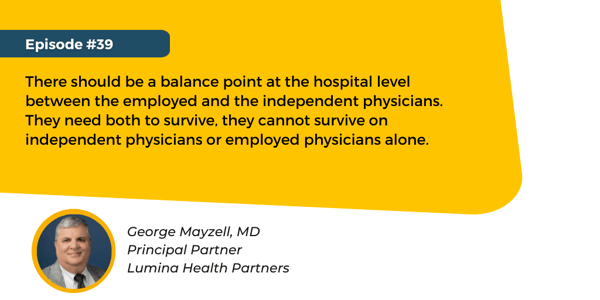Episode Overview:
Primary care services have been the foundation of the U.S. health care system for many years, but the primary care model is now in transition.
Today, primary care practices face a new set of challenges—and opportunities for growth—under a changing landscape that’s largely becoming redefined by large health systems. For today’s health care organizations, independent physician practices must choose their partners wisely and stay motivated to achieve success in this evolving environment.
In this episode, host Daniel J. Marino and George Mayzell, MD, discuss how leaders evaluate the evolving primary care model and strategies to support these changes.
Host:

Daniel J. Marino, Managing Partner, Lumina Health Partners
Guest:

Dr. George Mayzell, MD, Managing Principal, Lumina Health Partners
Episode Discussion Areas:
1. How has the primary care employment model changed?
-
- Primary care was traditionally hospital-focused employment.
- More recently, other stakeholders (such as venture capitalists and insurers) are offering more employment than hospitals.
- The access point now becomes under the purview of the organization and isn’t always totally at the primary care provider’s discretion.
- It’s challenging as primary care has become corporatized.
2. How should the C-suite respond to changes in primary care?
-
- There should be a balance point at the hospital level between the employed and independent physicians. They need both to survive; they cannot survive on independent or employed alone.
- Particularly on the specialty side, they can’t possibly employ everybody, so hospitals must figure out a good balance on how to treat their employed physicians.
- Hospitals must start thinking differently, as they are still trying to manage physicians as employees in a traditional sense. They have to treat professional employees a little differently.
3. What do you think the impact is with these new primary care models on value-based care contracts?
-
- One thing that must happen is the contracts, the incentive plan, and the employment models all must be aligned. If the payer contracts and the provider incentive model are not aligned, it does not work.
- All parties must be aligned and rewarded for doing the right thing.
4. Why is alignment so critical as primary care moves toward value-based care?
-
- Moving quickly to the new models — or staying as long as you can safely and comfortably in the old model — is probably to everybody’s advantage.
- It takes us a certain amount of experience and expertise to get in a position to win for everybody, including the patients.

10 Key Takeaways: Innovative Strategies to Support the Evolving Primary Care Model
- Instant access creates new issues.
Because patients can access primary care 24/7 virtually, primary care physicians are now competing for patients across the country. - Access has always been a challenge in primary care employment models.
That’s an area of weakness and vulnerability for patients and for growing the network. External organizations and commercial carriers are capitalizing on that weakness of access and using it to their advantage. - Many models outside the hospital are moving toward value-based care.
Contracts are supporting more efficient care, keeping patients out of the hospital, rewarding access at the financial level, and keeping the attribution models strong. - The C-suite must focus on primary care services to maintain patient connections, manage access, and build convenient-based services.
These points are critical within the primary care setting as they impact financials, physician compensation, strategic partnerships, and specialists’ success. - There’s a balance point at the hospital level between the employed and the independent physicians.
They can’t survive on each alone, so they must strike a balance on how they treat employed physicians and support specialists. Professional employees must be treated differently, ensuring values and incentives are aligned. - What’s the impact on value-based care contracts?
Potentially positive. Aligning contracts, incentive plans, and employment models incentivizes physicians and the health system for doing the right thing. If 20%-30% of revenues are tied to a value-based care component, overutilization can sometimes hurt the performance of that contract. - How are private equity groups having an effect?
In some models, private equity groups are siphoning off the desirable payer-mix and patients who “aren’t that sick,” leaving a gap that won’t be filled. These groups are often provider-agnostic and play to all markets, creating a significant economic impact. - How does the primary care physician survive right now?
The physician must be strategic and watch their financial and strategic environment. It means considering things they didn’t have to before: financials, cost structures, contracts, etc. Patients have limited loyalty as they depend on their health plan. - Health care is different today.
Patients are much more knowledgeable, thanks to internet research, and there’s a lot more information available. Providers ask patients, “What do you understand about your disease from the internet?” And that can make care harder. - What are the takeaways from this evolution?
We must understand the weaknesses and the vulnerability points relating to primary care. Aligning reimbursements with physician compensation, performance, and outcomes is a big step.
About Value-Based Care Insights Podcast
Value-Based Care Insights is a podcast that explores how to optimize the performance of programs to meet the demands of an increasing value-based care payment environment. Hosted by Daniel J. Marino and Shaillee Juneja, the VBCI podcast highlights recognized experts in the field and within Lumina Health Partners.





Share this: